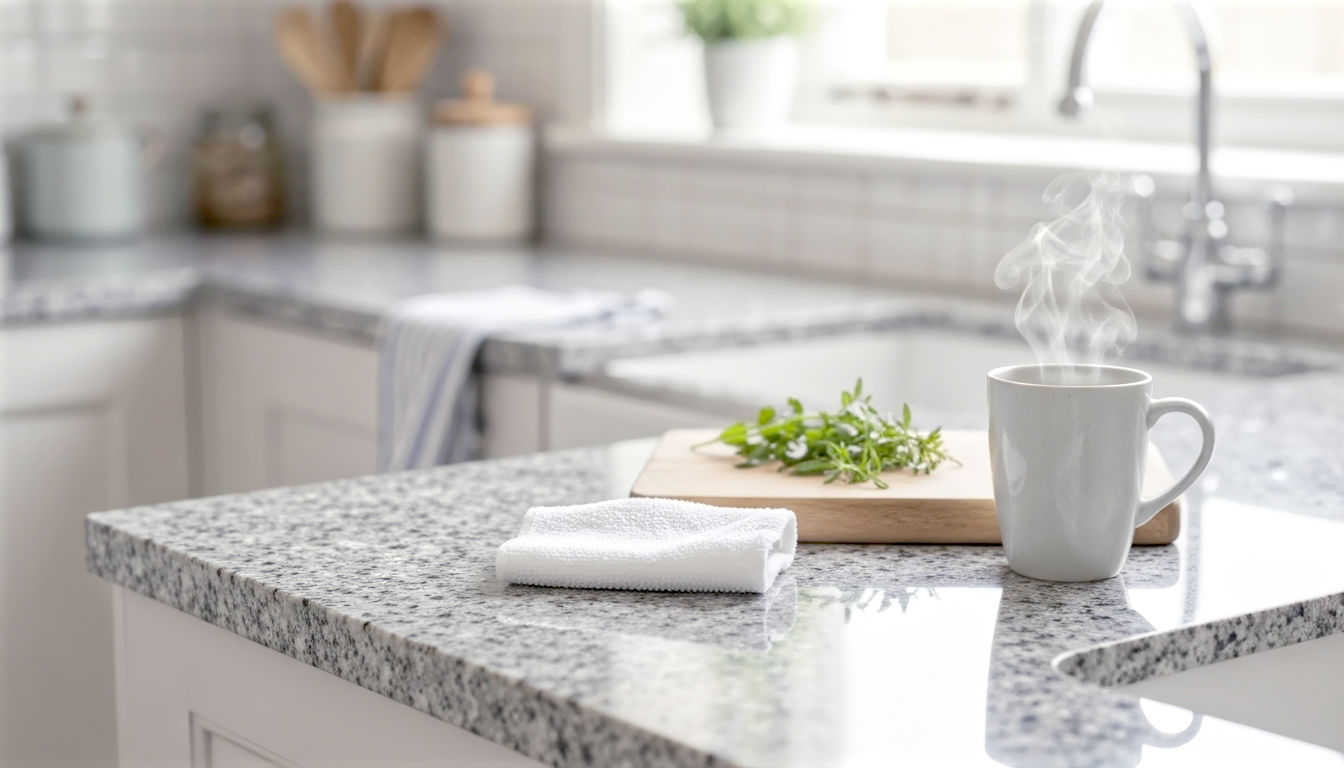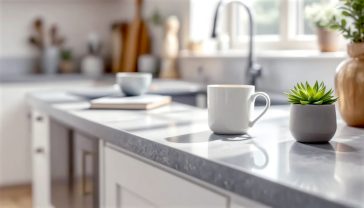The Great British Worktop Debate: Are Granite Countertops Really a Doddle to Look After?
Worried granite is hard work? Discover the simple, no-nonsense daily cleaning routines and sealing secrets to keep your kitchen worktops looking brand new for years.

This post may contain affiliate links. If you make a purchase through these links, we may earn a commission at no additional cost to you.
Picture this: you’re halfway through a Sunday roast. The kitchen is a whirlwind of activity. Gravy is bubbling, potatoes are roasting, and a glass of red wine is perched precariously close to the edge of your gleaming kitchen worktop. If that worktop is granite, does that scene fill you with a sense of calm confidence or a jolt of pure panic?
For decades, granite has been the undisputed king of British kitchens. It whispers luxury, durability, and timeless style. Flick through any home magazine or watch a property show, and you’ll see it everywhere, from sleek city flats in Manchester to cosy country cottages in the Cotswolds. It’s become a symbol of an aspirational home, a sign that you’ve ‘made it’.
But here’s the rub. For all its good looks, there’s a persistent rumour that follows granite around like a shadow. Is it, well, a bit of a diva? Is it secretly high-maintenance, demanding constant attention and special treatment, ready to stain at the mere sight of a lemon slice?
We’re here to settle the score once and for all. This is the definitive, no-nonsense guide to granite worktop care. We’ll cut through the myths, bust the jargon, and give you the straight-talking advice you need. We’ll explore what granite actually is, how it stands up to the chaos of a real family kitchen, and exactly what you need to do to keep it looking as stunning as the day it was installed. So, grab a cuppa, and let’s find out if granite is truly the low-maintenance dream it promises to be, or a demanding feature that needs more TLC than you might think.
What Exactly Is This Rock in My Kitchen? Understanding Granite
Before we can talk about looking after it, we need to get to grips with what granite actually is. It’s not something cooked up in a lab; it’s a completely natural stone, born deep within the Earth’s crust.
Think of it like a very, very old and very slow-cooked cake. It’s an igneous rock, which is a fancy way of saying it was formed from molten rock, or magma. Over millions of years, this scorching hot liquid cooled down incredibly slowly, deep underground. This slow cooling process is the magic ingredient. It allowed large crystals of different minerals to grow, locking together to form the incredibly hard, speckled, and swirly patterns that we recognise as granite.
The main minerals that make up granite are:
- Quartz: This is one of the toughest minerals on Earth. It’s what gives granite its hardness and durability. You can thank quartz for the fact that your worktop can shrug off most scratches.
- Feldspar: This is the most abundant mineral in granite. It’s what gives the stone its main base colour, which could be anything from a pearly white or soft pink to a deep black.
- Mica: This mineral adds the sparkle! The little glittery bits you see catching the light in your worktop are flakes of mica.
The unique mix of these minerals, and a few others, is what makes every single slab of granite one-of-a-kind. The granite quarried in Brazil will have a completely different look to granite from India or Italy. This is why you’ll never find two granite worktops that are absolutely identical.
Is Granite Porous? The Sealing Question
Now for the most important bit when it comes to maintenance: porosity.
Because granite is a natural stone formed from interlocking crystals, it has tiny, microscopic gaps and pores between those crystals. Think of it like a very, very dense sponge. This means that, if left unprotected, liquids can seep into these pores. This is why you hear horror stories about red wine, olive oil, or curry sauce leaving a permanent mark.
This is where sealing comes in. A granite sealer is a liquid that’s designed to soak into these pores and plug them up. It creates an invisible protective barrier that sits just below the surface of the stone. This barrier stops liquids from getting in, giving you time to wipe up spills before they can cause a stain.
Crucially, a newly installed granite worktop from a reputable UK supplier should always come pre-sealed. They do this as standard. The big question, which we’ll dive into later, is how often you need to re-seal it. The answer isn’t as scary as you might think.
The Daily Grind: Looking After Your Granite Day-to-Day
Right, let’s get down to brass tacks. What do you actually need to do on a daily basis to keep your granite happy? The good news is, it’s incredibly simple. Granite is tough stuff, and it’s designed for the hustle and bustle of a busy kitchen.
Your Daily Cleaning Toolkit: Simple is Best
Forget what you’ve seen in fancy adverts. You don’t need an arsenal of expensive, specialist sprays for everyday cleaning. In fact, some of them can do more harm than good.
All you really need is:
- A soft cloth: A microfibre cloth is perfect. It’s gentle and brilliant at picking up crumbs and dust without scratching.
- Warm water: Good old-fashioned H₂O is your best friend.
- A tiny drop of washing-up liquid: We’re talking a pea-sized amount in a bowl of warm water. A pH-neutral soap is ideal. Most standard washing-up liquids like Fairy are perfectly fine for this.
That’s it. That’s your daily cleaning kit.
The 30-Second Daily Wipe-Down
The best habit you can get into is giving your worktops a quick wipe at the end of the day.
- Step 1: Clear the surfaces of any crumbs or food bits.
- Step 2: Dip your microfibre cloth in the warm, slightly soapy water.
- Step 3: Wring the cloth out so it’s damp, not soaking wet.
- Step 4: Wipe down the entire surface.
- Step 5: Take a second, dry microfibre cloth and buff the surface dry. This is the secret to avoiding streaks and water marks and getting that beautiful, reflective shine.
This whole process takes less than a minute, and it’s the single most effective thing you can do to keep your granite looking pristine.
Dealing with Spills: Don’t Panic, Just Mop Up
Life is messy. Spills are going to happen. Thanks to your granite’s sealer, you have a window of opportunity. The liquid will ‘bead up’ on the surface, sitting on top of that invisible barrier.
The golden rule is simple: blot, don’t wipe.
If you wipe a big spill, you risk spreading it over a wider area. Instead, grab a paper towel or a dry cloth and gently blot the liquid up, starting from the outside of the spill and working your way in. Once you’ve soaked up the bulk of it, you can use your damp, soapy cloth to clean the area and a dry cloth to buff it.
What about common culprits?
- Wine, fruit juice, coffee: These are acidic. Mop them up as soon as you see them.
- Oil, butter, greasy foods: These can be particularly nasty as they can penetrate the sealer if left for a long time. Clean them up promptly.
- Water: Even water can be a pain if you live in a hard water area, common across much of the UK. Limescale can build up around taps. Buffing the area dry after use is the best way to prevent this.
The key takeaway for daily care is that it’s more about forming simple, quick habits than undertaking a major cleaning chore. It’s about little and often.
Granite’s Arch-Enemies: What You MUST Avoid
Granite may be tough, but it’s not indestructible. There are a few household products and habits that can strip its protective seal, dull its shine, or even damage the stone itself. Avoiding these is just as important as your daily cleaning routine.
Think of your granite’s sealer as its armour. Your job is to protect that armour.
1. Harsh and Acidic Cleaners
This is public enemy number one. Never, ever use harsh chemical cleaners on your granite. This includes:
- Bleach: It’s far too aggressive and can damage the sealer and discolour the stone.
- Standard kitchen or bathroom sprays: Products like Flash, Cillit Bang, or Dettol kitchen sprays often contain harsh chemicals or acidic ingredients. They might make your taps sparkle, but they will degrade your granite’s sealer over time, leaving it vulnerable to stains.
- Vinegar or lemon juice: While they’re brilliant natural cleaners for some surfaces, their acidity is a major problem for granite. Regularly using vinegar will eat away at the sealer. An accidental splash of lemon juice that’s wiped up quickly is fine, but don’t use it as a cleaner.
- Glass cleaner: Many glass cleaners contain ammonia, which is another chemical that can dull the surface of your granite and weaken the seal.
If in doubt, stick to soapy water. If you want a dedicated granite cleaner for a deeper clean, make sure it is specifically labelled as pH-neutral and safe for natural stone.
2. Abrasive Scrubbers and Powders
Granite is highly scratch-resistant, but that doesn’t mean you should take a Brillo pad to it.
- Avoid scouring pads: The green, scratchy side of a kitchen sponge or wire wool can create tiny, micro-scratches on the surface. Over time, these will dull the finish.
- Avoid abrasive powders: Cream cleaners like Cif or powders like Ajax can also cause these micro-scratches. They’ll ruin that beautiful polished look.
If you have a stubborn, dried-on bit of food, don’t reach for the scourer. Instead, wet the area with your soapy water, let it sit for a few minutes to soften the gunk, and then gently scrape it off with a plastic scraper or even an old credit card.
3. The Big No-Nos: Heat and Impact
Direct Heat: While granite is very heat-resistant (it was formed from magma, after all!), it’s not immune to something called ‘thermal shock’. Placing a scorching hot pan straight from the hob or oven directly onto the cool stone can, in very rare cases, cause a tiny fracture or crack. More commonly, it can damage the sealer in that spot. It’s a simple habit to get into: always use a trivet or a pot stand.
Heavy Impacts: Granite is incredibly hard, but it’s also crystalline. A very heavy, sharp impact – like dropping a cast-iron casserole dish on an edge or corner – can cause a chip. The edges and corners are the most vulnerable parts of your worktop. Just be mindful when handling heavy cookware near them.
The Deep Clean and The Sealing Ritual
Okay, so the daily stuff is a breeze. But what about the bigger jobs? How do you give your granite a proper deep clean, and how often do you really need to tackle that dreaded re-sealing?
The Occasional Deep Clean
Every few weeks, or whenever you feel your worktop needs a bit of extra love, you can give it a more thorough clean. This is where a dedicated, pH-neutral stone cleaner comes in handy. You can buy these from hardware shops like B&Q, online, or from your worktop supplier.
Simply follow the instructions on the bottle. Usually, it’s a case of spraying it on, leaving it for a minute or two, and then wiping it off with a clean, damp cloth before buffing dry. This will lift any residue from daily use and restore that showroom sparkle.
De-Mystifying Sealing: The Water Test
This is the big one. The fear of having to constantly re-seal granite is what puts many people off. But the reality is much less demanding.
How often do you need to re-seal? It depends on the type of granite (darker granites are often denser and less porous than lighter ones) and how much use your kitchen gets. A good rule of thumb is once every 1 to 3 years. Some very dense granites might go even longer.
But you don’t need to guess. There’s a very simple test you can do yourself. It’s called the water test.
- Pour a small puddle of water, about the size of a 50p coin, onto the worktop in a few different places (especially in high-use areas like near the sink).
- Leave it for about 15-20 minutes.
- Wipe the water away and look at the stone.
- If the water has left a dark patch or mark, it means the water has started to soak into the stone. The sealer is wearing thin. It’s time to re-seal.
- If there is no change to the colour of the granite, your sealer is still doing its job perfectly. You don’t need to do anything.
That’s all there is to it. This simple test removes all the guesswork.
How to Re-Seal Your Worktop: A DIY Guide
If the water test shows it’s time to re-seal, don’t panic. It’s a straightforward DIY job that you can easily do in an afternoon.
What you’ll need:
- A bottle of granite sealer (you can buy this from the same places as the cleaner).
- A couple of clean, lint-free cloths (microfibre is ideal).
- Some masking tape (optional, to protect your hob and sink).
The Process:
- Clean and Dry: First, give your worktop a thorough clean with a stone cleaner or a mix of water and a little bit of isopropyl alcohol to remove any grease or residue. Let it dry completely. The stone must be bone dry for the sealer to penetrate properly. Wait at least a few hours, or even overnight, after cleaning.
- Ventilate: Open your kitchen windows and doors. The sealer can have a strong smell, so good ventilation is important.
- Apply the Sealer: Following the instructions on the bottle, apply the sealer. Most tell you to pour a small amount onto the worktop and spread it evenly in a thin layer using one of your clean cloths. Work in small, manageable sections.
- Let it Penetrate: This is the crucial step. You need to let the sealer soak into the stone. The instructions will tell you how long for – usually between 5 and 15 minutes. During this time, the surface might look a bit wet or oily. Don’t let it dry on the surface. If you see some areas absorbing the sealer faster than others (they’ll start to look dry), apply a little more to that spot.
- Remove the Excess: After the penetration time is up, take your second, clean, dry cloth and wipe off all the excess sealer from the surface. This is really important. If you let the excess sealer dry on top, it will leave a hazy, streaky residue that is a nightmare to get off.
- Buff: Once all the excess is removed, give the whole surface a good buff with a dry cloth.
- Cure: The sealer needs time to ‘cure’ fully. The bottle will give you a timeframe, which could be anything from 24 to 72 hours. During this time, try to be gentle with your worktops. You can use them, but avoid spills and don’t put anything heavy or wet on them if you can help it.
And that’s it. You’ve just successfully re-sealed your granite worktop, protecting it for another few years. It’s a bit like waxing a car – a bit of effort once in a while keeps it protected and looking its best.
Common Granite Problems and How to Fix Them
Even with the best care, accidents can happen. Here’s a quick troubleshooting guide for the most common granite grievances.
Help! I’ve Got a Stain!
First, identify the stain. What caused it will determine how you treat it.
- Organic Stains (tea, coffee, wine, fruit): These are the most common. You can often lift these with a poultice. Mix a paste of baking soda and a small amount of hydrogen peroxide until it’s the consistency of thick peanut butter. Apply the paste to the stain, cover it with cling film, and tape down the edges. Let it sit for 24 hours. The poultice should slowly draw the stain out of the stone. Afterwards, gently scrape the paste off, clean the area with water, and dry it.
- Oil-Based Stains (grease, cooking oil, milk): These will look like a dark mark. The poultice method works here too, but instead of hydrogen peroxide, mix the baking soda with a little bit of water to make the paste.
- Water Stains / Limescale: This is usually a surface issue, especially around taps. A dedicated limescale remover that is specifically marked as safe for natural stone is the best bet. Don’t use standard Viakal! If it’s not too bad, you can try gently scrubbing with a soft-bristled brush and your pH-neutral cleaner.
My Worktop Looks Dull and Streaky
This is almost always caused by one of two things:
- Soap build-up: If you use too much washing-up liquid in your daily clean, a thin, invisible film can build up over time, dulling the shine. The fix is to give it a good clean with a proper stone cleaner or a solution of isopropyl alcohol and water to cut through the soap residue. Remember to buff it dry afterwards.
- Sealer residue: This happens if excess sealer was left to dry on the surface. This is trickier to fix and might require a specialist stone product designed to strip sealer. It’s best to call a professional in this case to avoid damaging the stone.
I’ve Chipped the Edge!
Small chips, especially on the edges, can happen. For tiny nicks, a DIY repair kit can work. These usually involve a coloured epoxy resin that you use to fill the chip. You match the colour to your granite, fill the gap, let it harden, and then carefully shave it level with a razor blade.
For larger chips or cracks, it’s definitely a job for a professional stone mason. They can repair it in a way that is virtually invisible.
The Verdict: So, Are Granite Worktops Easy to Look After?
Let’s circle back to our original question. After everything we’ve covered, what’s the final answer?
Yes, granite worktops are surprisingly easy to look after.
The reputation they have for being ‘high-maintenance’ is largely a myth, born from a lack of understanding. The reality is that granite care isn’t difficult, it’s just different from looking after a laminate or quartz worktop.
It boils down to this:
- The daily care is incredibly simple: A quick wipe with a soft cloth and soapy water is all it takes.
- The key is avoiding the wrong products: Keeping harsh chemicals and acids away from your worktop is the most important rule.
- Sealing is not a constant chore: It’s a simple DIY task you might only have to do once every few years, and the water test makes it easy to know when.
Granite is a fantastic investment for any British home. It’s a beautiful, natural, and incredibly durable material that can genuinely last a lifetime. It handles the heat, the spills, and the chaos of family life with remarkable grace.
If you can get into the simple habit of wiping up spills, using a chopping board, and putting hot pans on a trivet, you’ll find that your granite worktop isn’t a demanding diva at all. It’s a tough, reliable, and beautiful workhorse that asks for very little in return. It will reward your minimal effort by looking effortlessly elegant for decades to come, becoming the true heart of your home.
Further Reading & Resources
For those looking to delve deeper, here are some highly respected resources and organisations in the UK:
- The Stone Federation of Great Britain: The official trade association for the natural stone industry in the UK. A great source for technical information and finding accredited professionals.
- Worktop Fabricators Federation (WFF): An organisation promoting best practices and quality standards for worktop fabrication and installation.
- Lithofin UK: A leading manufacturer of specialist products for cleaning, protecting, and maintaining natural stone. Their website has a wealth of advice.






